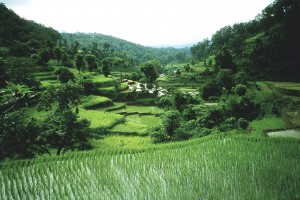It Takes a Global Village to Plant and Manage a Trillion Trees
It Takes a Global Village to Plant and Manage a Trillion Trees
Author: Dr. John A. Stanturf
John Stanturf is a Visiting Professor at the Estonian University of Life Sciences, Tartu, Estonia, and Senior Restoration Specialist at InNovaSilva, Vejle, Denmark.
He is Deputy Coordinator of the IUFRO Task Force on “Transforming Forest Landscapes for Future Climates and Human Well-Being”.

Tree planting to combat climate change is wildly popular. Several countries and many organizations talk about planting billions or trillions of seedlings. Contrary viewpoints have also hit the popular press and scientific journals, pointing out that the need to reduce GHG emissions still remains the greatest challenge. Overlooked in many of these high profile news items is the reality that tree planting is not a simple activity; to be successful, we must plant the right trees, in the right places, at the proper time for young seedlings to prosper, grow, and eventually provide multiple benefits including biodiversity. Because it takes several decades until restored forests reach desired carbon sequestration levels, long-term management of forests and trees is key. And establishing new forests is even more complicated; successful tree planting requires planting stock grown with specific traits to meet the challenges of particular sites and the restoration objectives. Focusing only on planting ignores everything that is needed to get to the point of planting seedlings, including seed collection, processing, and nursery practices through to caring for seedlings after planting.
National Forest Programmes
The time is right to learn from past experiences and build a second-generation of “National Forest Programmes”
By Alexander Buck, Helga Pülzl and Ewald Rametsteiner
 Since their conception more than two decades ago, national forest programmes (NFP) have become widespread forest policy frameworks internationally. The management of most of the world’s forests is now governed by different types of NFPs to some degree. Hence NFPs present certain governance practices that all countries are interested to have. Yet, the overall picture regarding the impact of NFPs as national forest governance frameworks on sustainable forest management remains ‘fuzzy’. Read more…
Since their conception more than two decades ago, national forest programmes (NFP) have become widespread forest policy frameworks internationally. The management of most of the world’s forests is now governed by different types of NFPs to some degree. Hence NFPs present certain governance practices that all countries are interested to have. Yet, the overall picture regarding the impact of NFPs as national forest governance frameworks on sustainable forest management remains ‘fuzzy’. Read more…
Enhancing forest-related development: Community and smallholder forestry in the nexus of markets, policy, and implementation
Forests hold the potential to contribute to sustainable local development in many regions of the world. For this potential to be realized, rural dwellers need to have access to healthy forests, need to be linked to markets, and hold capacities to actively engage in forest product value chains. This requires an enabling legal environment and supportive policies. For the last two decades, considerable efforts and investment have been devoted to improve these enabling conditions in many locations and at different scales. Even so, in many places in the world where a forestry development potential may exist, deforestation and forest degradation, unfavourable legal environments and policies and competition with better endowed or politically well-connected entrepreneurs prevail. Read more…
Lessons from a global perspective on tree health
 Professor Michael J Wingfield, President of IUFRO and Director of the Forestry & Agricultural Biotechnology Institute, University of Pretoria gives an insight on his forthcoming presentation at 2015 ICF National Conference: Tree health, resilience and sustainability.
Professor Michael J Wingfield, President of IUFRO and Director of the Forestry & Agricultural Biotechnology Institute, University of Pretoria gives an insight on his forthcoming presentation at 2015 ICF National Conference: Tree health, resilience and sustainability.
Natural forests and plantations of forest trees are increasingly threatened by insect pests and pathogens. Broadly speaking, native trees in forests are most seriously threatened. Once a serious disease cause by a pest, pathogen or a combination of these factors in symbiosis, there is little that can be done to offset the problem. Classic examples are found in Dutch elm disease, chestnut blight. Read more…
Summer Students at IUFRO Headquarters
During 4 weeks in July, three young students worked at IUFRO Headquarters to get a taste of work in an office. Here is their report:
When you work for IUFRO, you have to be prepared for a wide range of different tasks such as setting up a filing system, sorting notes or getting the mail. One of the most exciting assignments we got was to prepare a draft on how to improve and reorganize the IUFRO webpage according to our own vision. The three of us put together our ideas and debated how the webpage could be changed in order to be more attractive to users not familiar with IUFRO, and still be easy for all users to operate with.
IUFRO Headquarters is a very nice place to work at. While there is a lot of work to be done, the atmosphere is pleasant and relaxed. Everyone is very cooperative and helpful. In our work, we did not have to worry about time pressure, but were encouraged to finish all our tasks properly.
Since the members of IUFRO Headquarters were very busy with their usual tasks, such as doing the finances, organizing meetings, writing reports or minutes, they were highly pleased that we took over extra tasks for them and so facilitated their work.
We learned much: not only about the work of IUFRO and its member organizations, but also about the functioning and logistics of a big association, like IUFRO, and its headquarters. The time here at IUFRO was a highly informative and instructive, as we learned to work within a group, but at the same time independently. And we now have an idea what it is like to work in an office of an international association.
Jonathan Kleine, Julian Koch, Moritz Wildburger
Photo: IUFRO Headquarters
Watch an Informational Video about IUFRO
Your Internet Gateway to Forest Information Resources – GFIS
The Global Forest Information Service (GFIS) provides the framework to share forest-related information through a single gateway at www.gfis.net. It promotes the dissemination and sharing of forest and tree-related information and knowledge among the global forestry community by developing common information exchange standards, building capacity and enhancing partnerships among forestry information providers and users. Read more…


